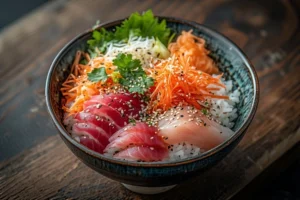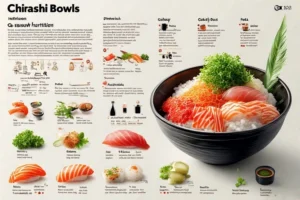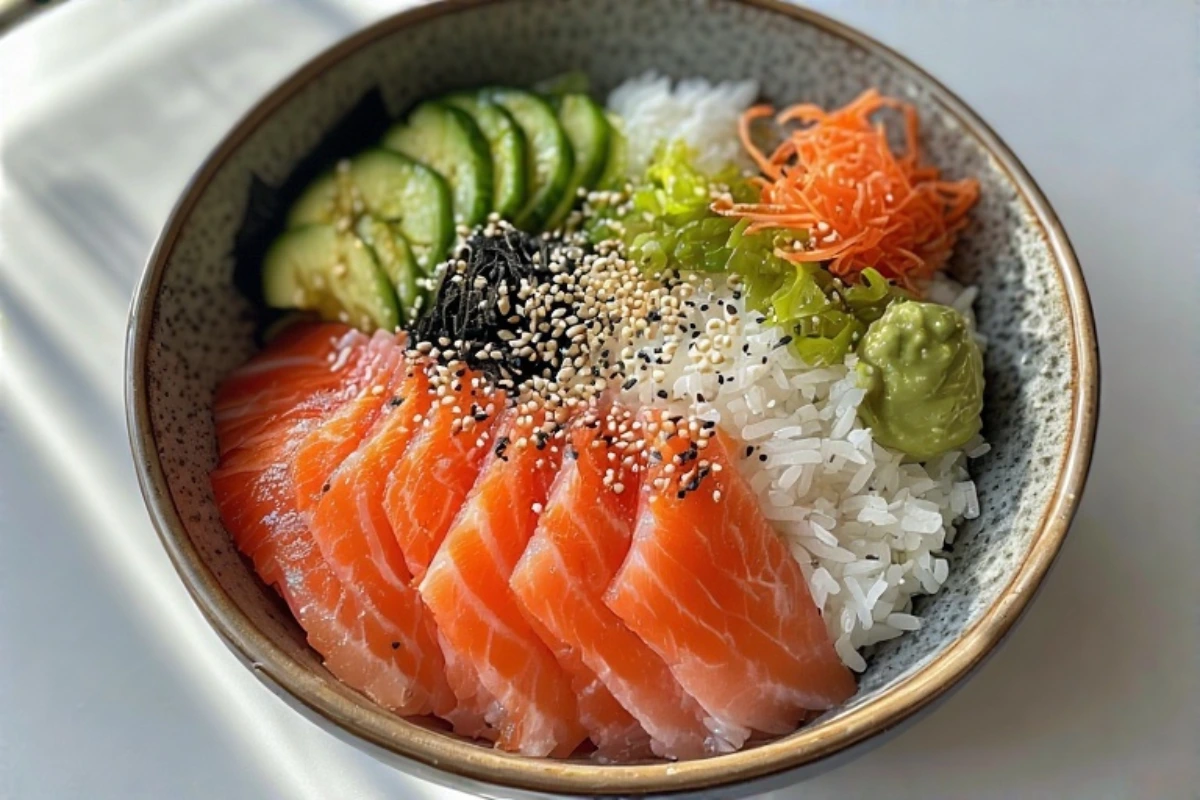Chirashi Sushi: Discover the Art, Flavor, and Culture of Chirashi Bowls
🗂️ Post Navigation
ToggleA Personal Journey Into the World of Chirashi
Imagine sitting down to a bowl that tells a story through colors, textures, and flavors. That first experience with chirashi sushi can feel like opening a box of edible treasures—each bite a surprise, each ingredient playing its own part in a harmonious whole. Maybe you’ve seen it on a menu or scrolled past a vibrant photo online. Maybe you’ve even tried a version and thought, “What exactly is chirashi?” This guide will take you through everything you need to know about chirashi sushi bowls, so you can not only understand what you’re eating but also appreciate the cultural significance behind each component.
What Is Chirashi? An Introduction to Chirashi Sushi
Understanding the Chirashi Concept
Chirashi, short for chirashizushi, literally means “scattered sushi” in Japanese. It features a bowl of seasoned sushi rice topped with a variety of ingredients, most commonly slices of raw fish, vegetables, egg, and seaweed. Unlike sushi rolls or nigiri, chirashi is unrolled and artistically scattered, allowing for more creativity and variety in toppings.
This dish dates back to the Edo period and remains a beloved staple in both traditional and modern Japanese cuisine. Whether served at high-end sushi counters in Tokyo or crafted at home, chirashi offers a versatile and visually stunning meal.
Variants of Chirashi
There isn’t just one way to make chirashi. Regional differences and culinary innovation have led to several distinctive styles:
Edomae Chirashi: The Tokyo-style version often includes fresh sashimi neatly arranged over a bed of vinegared rice.
Gomoku Chirashi: Common in Kansai (Western Japan), this variation features cooked ingredients mixed directly into the rice.
Modern Fusion Chirashi: Incorporates global ingredients like avocado, spicy mayo, or even quinoa, creating a chirashi bowl that blends cultures.
Chirashi vs. Other Sushi Styles
Chirashi vs. Nigiri
At a glance, chirashi might seem like an unassembled sushi platter, but it serves a different experience. Nigiri focuses on precision—a slice of fish on hand-molded rice. Chirashi, on the other hand, lets you enjoy multiple textures and flavors in a single bowl. It’s less formal but equally refined.
Chirashi vs. Sashimi Bowls
Sashimi bowls skip the seasoned rice, often serving fish over plain rice or without any grain at all. Chirashi brings the flavor of vinegared rice, which adds an important dimension to the eating experience. If you enjoy variety and a little more complexity, chirashi offers that in every scoop.
Why Choose Chirashi Sushi?
Convenience: All ingredients in one bowl—no need for rolling or slicing.
Customizability: You can personalize your chirashi with toppings you love.
Nutrition: A balanced meal with proteins, carbs, and veggies.
Chirashi Sushi Ingredients & Preparation
Essential Ingredients for Classic Chirashi
Here’s what you’ll typically find in a traditional chirashi bowl:
How to Prepare Chirashi Sushi at Home
You don’t need a sushi chef’s training to make chirashi at home. Here’s how:
Cook the rice: Use short-grain sushi rice and season it with rice vinegar, sugar, and salt.
Slice the fish: Make sure to use sashimi-grade fish and cut it against the grain.
Prep toppings: Slice cucumbers, cook and cut tamago, prep garnishes.
Assemble: Spread rice in a bowl, then artistically arrange toppings.
Garnish: Sprinkle sesame seeds, pickled ginger, or wasabi as desired.

Where to Find the Best Chirashi Sushi
Top Chirashi Sushi Spots Globally
If you’re looking to taste the best chirashi without stepping into your kitchen, these are the places to go:
Tokyo: Tsukiji Outer Market
New York: Sushi Yasuda
Los Angeles: Sugarfish
London: Sushi Tetsu
What to Look For in a Good Chirashi Bowl
Fish freshness: The fish should be sashimi-grade and smell clean.
Ingredient balance: Look for bowls with protein, vegetables, and garnishes.
Presentation: A good chirashi bowl is as beautiful as it is delicious.
Nutritional Benefits of Chirashi
Balanced Nutrition in One Bowl
Chirashi sushi is more than a delight to your senses—it’s also good for your body. Here’s why:
Lean proteins: Fish like tuna and salmon offer high-quality protein.
Heart-healthy fats: Omega-3s found in fatty fish support brain and heart health.
Fiber and vitamins: Vegetables and seaweed bring essential nutrients.

Chirashi Sushi Variations Around the World
Western-Inspired Chirashi Bowls
You might notice chirashi bowls outside of Japan look a little different:
Poke-style Chirashi: Often served with spicy mayo and toppings like avocado.
Alternative grains: Some swap sushi rice for brown rice or quinoa.
Vegan and Vegetarian Chirashi Options
You don’t need to eat fish to enjoy chirashi:
Tofu cubes or marinated tempeh
Avocado slices, pickled carrots, and shiitake mushrooms
Use tamari or citrus-based dressings instead of soy sauce
Chirashi Sushi for Special Occasions
Chirashi in Japanese Celebrations
Chirashi isn’t just everyday food—it holds a place in celebration:
Hinamatsuri (Girl’s Day): Bright and colorful chirashi bowls are prepared for young girls in Japan.
New Year’s: A symbol of prosperity and harmony.
Making Chirashi a Festive Meal at Home
You can elevate your chirashi with:
Seasonal ingredients like cherry blossom flakes in spring
Decorative plating with edible flowers
Themed toppings for holidays or birthdays
FAQ About Chirashi Sushi
What Is Chirashi Sushi Exactly?
Chirashi sushi is a type of Japanese dish that features vinegared sushi rice topped with a variety of ingredients, often including raw fish, vegetables, and egg.
Can I Make Chirashi Without Raw Fish?
Absolutely. You can create vegetarian or even fully vegan chirashi bowls with tofu, mushrooms, and colorful veggies.
Is Chirashi Healthier Than Other Sushi?
It often is, thanks to its variety and lack of heavy sauces or fried ingredients.
What’s the Best Rice for Chirashi?
Short-grain Japanese sushi rice is ideal for its stickiness and flavor absorption.
How Should Chirashi Be Eaten?
You can gently mix the ingredients or savor them one bite at a time. It’s all about enjoying the contrast and harmony.
Conclusion: Embrace the Art and Joy of Chirashi
You now have a deeper understanding of what makes chirashi sushi so special. From its rich cultural history to the sheer diversity of flavors it offers, chirashi isn’t just a bowl of food—it’s a full sensory experience. Whether you’re crafting your own version at home or discovering a new favorite spot, chirashi is sure to leave a lasting impression.
Why not try making your own chirashi bowl tonight? Or share your favorite chirashi experience with others online. The world of scattered sushi is waiting for you to dive in.
Learn more about traditional Japanese cuisine at the Japanese Ministry of Agriculture.

